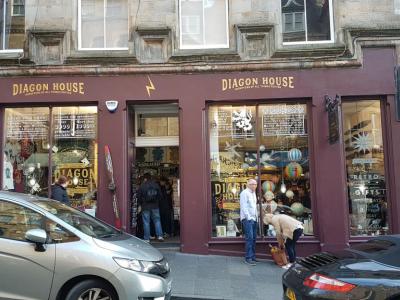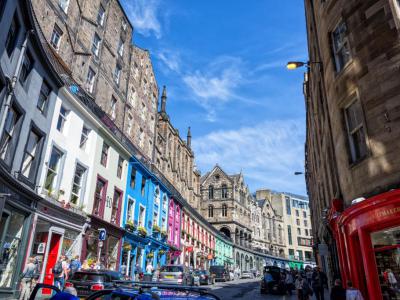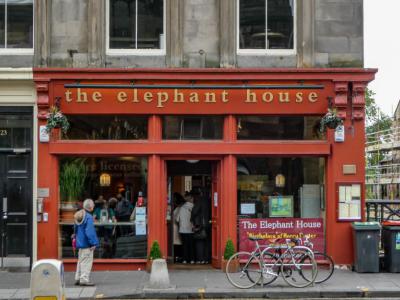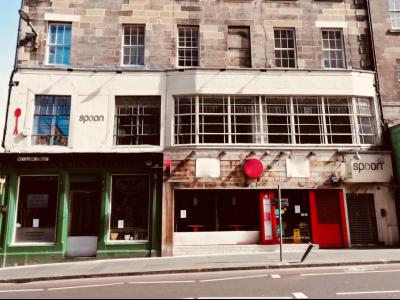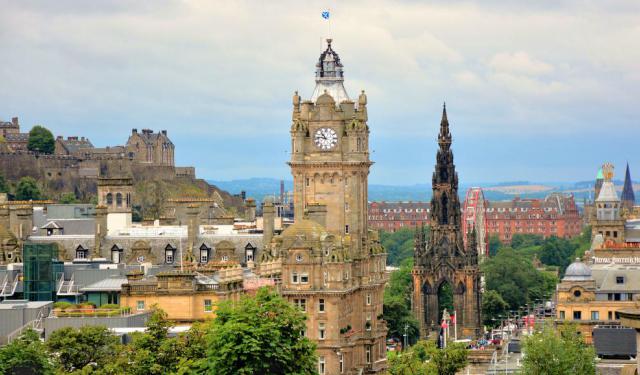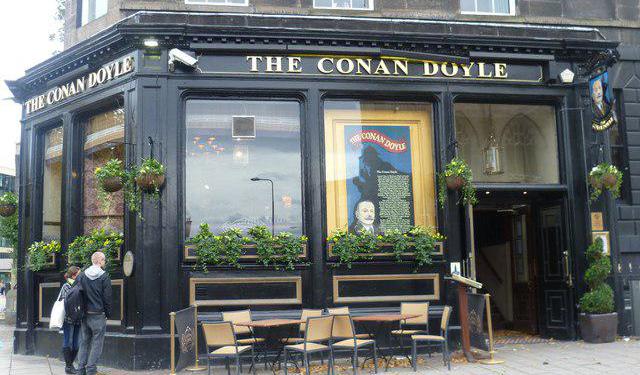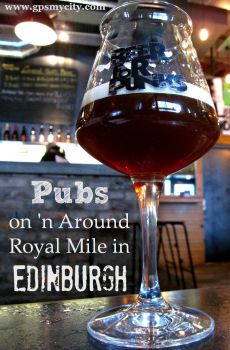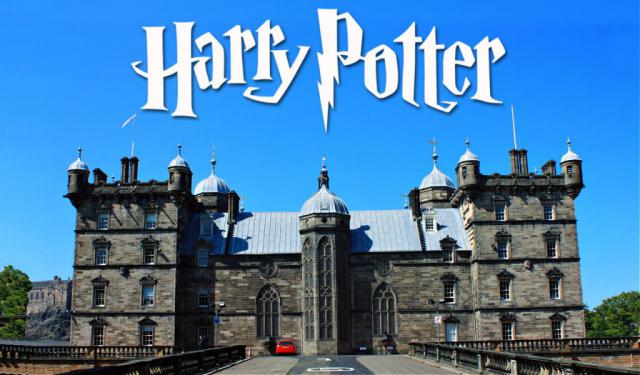
Harry Potter Trail (Self Guided), Edinburgh
Years after the release of the last Harry Potter book and movie, the cultural phenomenon of Harry Potter doesn't seem to fade away and the fandom continues strong as ever. Although by now Harry Potter has become a household name across the globe, the fact that J.K. Rowling penned some of the world's favorite wizarding stories in Scotland's capital, where she still lives now, makes Edinburgh a true Harry Potter's hometown.
Indeed, as you stroll around the city, you can see the streets and sights that have definitely (or probably) inspired the author, locations where she wrote chapters of the sensational saga, and shops themed on Harry Potter.
If you're keen on Harry Potter merchandise, make sure to visit the Diagon House, aka Museum Context. This quirky store on Victoria Street replicates the authenticity of Ollivander’s Wand Shop.
Heading further across the Grassmarket you will find the curve of Victoria Street and The West Bow, a colorful spot rumored to have been the prototype of London's magical shopping thoroughfare, Diagon Alley.
Prior to striking gold with her series, J.K. Rowling often sought refuge from the cold and wrote her early manuscripts in the welcoming Elephant House café on George IV Bridge – now deservedly regarded as the "birthplace" of Harry Potter.
In between her writing sessions, Rowling habitually walked around the city in search of inspiration, during which, perhaps somewhat morbidly, she would find herself in the nearby Greyfriar's Churchyard and look at the gravestones, with some of the names eventually slipping into her books.
Even though the location of Hogwarts has never been officially identified, some reckon it's been based on George Heriot's School.
For a genuine Harry Potter fan, adding Edinburgh to their travel bucket list is a must. To visit these and other locations associated with the World of Magic, take this self-guided Harry Potter walk and immerse yourself in the ultimate Harry Potter experience!
Indeed, as you stroll around the city, you can see the streets and sights that have definitely (or probably) inspired the author, locations where she wrote chapters of the sensational saga, and shops themed on Harry Potter.
If you're keen on Harry Potter merchandise, make sure to visit the Diagon House, aka Museum Context. This quirky store on Victoria Street replicates the authenticity of Ollivander’s Wand Shop.
Heading further across the Grassmarket you will find the curve of Victoria Street and The West Bow, a colorful spot rumored to have been the prototype of London's magical shopping thoroughfare, Diagon Alley.
Prior to striking gold with her series, J.K. Rowling often sought refuge from the cold and wrote her early manuscripts in the welcoming Elephant House café on George IV Bridge – now deservedly regarded as the "birthplace" of Harry Potter.
In between her writing sessions, Rowling habitually walked around the city in search of inspiration, during which, perhaps somewhat morbidly, she would find herself in the nearby Greyfriar's Churchyard and look at the gravestones, with some of the names eventually slipping into her books.
Even though the location of Hogwarts has never been officially identified, some reckon it's been based on George Heriot's School.
For a genuine Harry Potter fan, adding Edinburgh to their travel bucket list is a must. To visit these and other locations associated with the World of Magic, take this self-guided Harry Potter walk and immerse yourself in the ultimate Harry Potter experience!
How it works: Download the app "GPSmyCity: Walks in 1K+ Cities" from Apple App Store or Google Play Store to your mobile phone or tablet. The app turns your mobile device into a personal tour guide and its built-in GPS navigation functions guide you from one tour stop to next. The app works offline, so no data plan is needed when traveling abroad.
Harry Potter Trail Map
Guide Name: Harry Potter Trail
Guide Location: Scotland » Edinburgh (See other walking tours in Edinburgh)
Guide Type: Self-guided Walking Tour (Sightseeing)
# of Attractions: 8
Tour Duration: 2 Hour(s)
Travel Distance: 2.6 Km or 1.6 Miles
Author: Helen
Sight(s) Featured in This Guide:
Guide Location: Scotland » Edinburgh (See other walking tours in Edinburgh)
Guide Type: Self-guided Walking Tour (Sightseeing)
# of Attractions: 8
Tour Duration: 2 Hour(s)
Travel Distance: 2.6 Km or 1.6 Miles
Author: Helen
Sight(s) Featured in This Guide:
- Diagon House / Museum Context
- Victoria Street
- The Elephant House
- Greyfriars Church
- George Heriot's School
- Nicolson’s Cafe (now Spoon)
- Edinburgh City Chambers
- Balmoral Hotel
1) Diagon House / Museum Context
Museum Context, otherwise known as Diagon House, is the flagship store on Victoria Street. Similarly to its sister store at 42-44 Cockburn Street, this place is quite unique in terms of offering visitors and locals alike an authentic Harry Potter experience that celebrates Edinburgh as the birthplace of Harry Potter and J.K. Rowling’s wonderful legacy.
The brainchild of Alice and Andrew McRae, a conservation architect, this venue may appear a bit “scary” to the claustrophobic lot with its immersive shopping abundance, similar to that, perhaps, of the bustling Diagon Alley where Harry had to elbow his way through the sniggering Slytherins while purchasing his new year supplies.
Inside the shop you will find a world-class selection of officially licensed Harry Potter merchandise, which lures here Harry Potter pilgrims in their numbers from all over the globe, queuing up anxious to get in, from the early hours in the morning until the evening.
Having marked its 20th anniversary, the shop rebranded as Museum Context, honouring its eclectic Scottish collection.
The brainchild of Alice and Andrew McRae, a conservation architect, this venue may appear a bit “scary” to the claustrophobic lot with its immersive shopping abundance, similar to that, perhaps, of the bustling Diagon Alley where Harry had to elbow his way through the sniggering Slytherins while purchasing his new year supplies.
Inside the shop you will find a world-class selection of officially licensed Harry Potter merchandise, which lures here Harry Potter pilgrims in their numbers from all over the globe, queuing up anxious to get in, from the early hours in the morning until the evening.
Having marked its 20th anniversary, the shop rebranded as Museum Context, honouring its eclectic Scottish collection.
2) Victoria Street
Perhaps one of the most photographed locations in Edinburgh, Victoria Street in the Old Town, gently curved and adorned with colourful shopfronts, is indeed a much loved spot for tourist photos, postcards and TV adverts.
Built between 1829 and 1834, this street is the brainchild of architect Thomas Hamilton, the one who masterminded Edinburgh’s network of neo-classical wonders. On this occasion, though, he deviated from his habitual neo-classical stamp, being ordered to create architecture mimicking the Old Flemish style. For this purpose, many of the medieval buildings were torn down, while the notable arches, lining the new terrace, were turned into shops.
Lately, Victoria Street and the West Bow have had a certain amount of notoriety attached to them as possible prototypes for Diagon Alley, the wizards' market, featured in the Harry Potter books.
As the home base of JK Rowling, author of the Harry Potter books, Edinburgh is famed as a Potter pilgrimage destination. Packed with the higgledy piggledy medley of vibrant buildings, shops of all sizes and descriptions, noteworthy arches, cobblestones and general air of eccentricity, it’s no wonder that Victoria Street is seen as an inspiration for the ever-so fabulous Diagon Alley after all.
Built between 1829 and 1834, this street is the brainchild of architect Thomas Hamilton, the one who masterminded Edinburgh’s network of neo-classical wonders. On this occasion, though, he deviated from his habitual neo-classical stamp, being ordered to create architecture mimicking the Old Flemish style. For this purpose, many of the medieval buildings were torn down, while the notable arches, lining the new terrace, were turned into shops.
Lately, Victoria Street and the West Bow have had a certain amount of notoriety attached to them as possible prototypes for Diagon Alley, the wizards' market, featured in the Harry Potter books.
As the home base of JK Rowling, author of the Harry Potter books, Edinburgh is famed as a Potter pilgrimage destination. Packed with the higgledy piggledy medley of vibrant buildings, shops of all sizes and descriptions, noteworthy arches, cobblestones and general air of eccentricity, it’s no wonder that Victoria Street is seen as an inspiration for the ever-so fabulous Diagon Alley after all.
3) The Elephant House
Established since 1995, The Elephant House in Edinburgh has been renowned as one of the top destinations for tea and coffee connoisseurs. At some point, the place also grew famous through its association with J.K. Rowling, author of the bestselling Harry Potter series, who used to frequent this place, as an emerging writer, and wrote her early novels while sitting in the back room overlooking Edinburgh Castle.
Other literary patrons of The Elephant House, over the years, have included Ian Rankin, author of the Rebus novels, and Alexander McCall-Smith, author of The No.1 Ladies' Detective Agency, 44 Scotland Street and other novel series.
So, if you consider a writing career for yourself or seek inspiration, or simply want to savor a nice cup of tea or coffee prior to venturing out into historic Edinburgh, feel free to pop in and enjoy the place!
Other literary patrons of The Elephant House, over the years, have included Ian Rankin, author of the Rebus novels, and Alexander McCall-Smith, author of The No.1 Ladies' Detective Agency, 44 Scotland Street and other novel series.
So, if you consider a writing career for yourself or seek inspiration, or simply want to savor a nice cup of tea or coffee prior to venturing out into historic Edinburgh, feel free to pop in and enjoy the place!
4) Greyfriars Church
With a clear division into the Old and New Town, it's not hard to locate ancient buildings in Edinburgh. One such building – Greyfriar’s Church – is part of the Old Town.
Construction on the church began in 1602 and it was consecrated in 1630, becoming one of the oldest buildings in the Old Town. It was put up on the site of an abandoned Franciscan monastery and took its name from the monks who wore grey cassocks and were called “Grey Friars”.
In 1718, a dividing wall split the nave between the Old Greyfriars and New Greyfriars, so as to separate the Covenanters from the Roman Catholics worshipping inside the same church. In 1845, parts of the roof and the interior were destroyed by fire.
During restorations in the mid 19th century, beautiful stained-glass windows were added. It was the first time that such windows appeared in a Presbyterian church and it caused a bit of a scandal. A little later, an organ was added, causing yet another scandal. In 1929, the church was further renovated and, this time, the dividing wall was removed.
The adjoining graveyard is said to be haunted by the ghost of George Mackenzie, called the “Bloody” Lord Advocate for being responsible for the persecution of the Covenanters. According to legend, wherever his hand touches a living person, it leaves cuts and bruises.
Today the church hosts fashion shows, exhibitions, lectures and drama productions. The onsite museum showcases artefacts found in the area and recounts a comprehensive history of the Covenanters.
***Literary Landmarks & Harry Potter Tour ***
Hidden behind the Elephant House Café lies the historic Greyfriars Kirkyard which is now a place of interest for avid Harry Potter fans. Found here the grave of Thomas Riddell is said to have inspired JK Rowling to create the Tom Riddle (aka Lord Voldemort) character. Also, visible from here George Heriots School is said to be the template for fictional Hogwarts.
In addition to the gravestones of Robert Potter, Tom Riddell and William McGonagall found in the cemetary, there are others with potential links, such as Elizabeth Moodie (Mad-Eye Moody?) and Margaret Louisa Scrymgeour Wedderburn (Rufus Scrimgeour, the Minister of Magic in the final Harry Potter book?).
Starting August 2019, there is a Greyfriars Kirkyard map available to buy, locating all of the Harry Potter-themed gravestones. Proceeds from sales go to the upkeep of the grounds.
Construction on the church began in 1602 and it was consecrated in 1630, becoming one of the oldest buildings in the Old Town. It was put up on the site of an abandoned Franciscan monastery and took its name from the monks who wore grey cassocks and were called “Grey Friars”.
In 1718, a dividing wall split the nave between the Old Greyfriars and New Greyfriars, so as to separate the Covenanters from the Roman Catholics worshipping inside the same church. In 1845, parts of the roof and the interior were destroyed by fire.
During restorations in the mid 19th century, beautiful stained-glass windows were added. It was the first time that such windows appeared in a Presbyterian church and it caused a bit of a scandal. A little later, an organ was added, causing yet another scandal. In 1929, the church was further renovated and, this time, the dividing wall was removed.
The adjoining graveyard is said to be haunted by the ghost of George Mackenzie, called the “Bloody” Lord Advocate for being responsible for the persecution of the Covenanters. According to legend, wherever his hand touches a living person, it leaves cuts and bruises.
Today the church hosts fashion shows, exhibitions, lectures and drama productions. The onsite museum showcases artefacts found in the area and recounts a comprehensive history of the Covenanters.
***Literary Landmarks & Harry Potter Tour ***
Hidden behind the Elephant House Café lies the historic Greyfriars Kirkyard which is now a place of interest for avid Harry Potter fans. Found here the grave of Thomas Riddell is said to have inspired JK Rowling to create the Tom Riddle (aka Lord Voldemort) character. Also, visible from here George Heriots School is said to be the template for fictional Hogwarts.
In addition to the gravestones of Robert Potter, Tom Riddell and William McGonagall found in the cemetary, there are others with potential links, such as Elizabeth Moodie (Mad-Eye Moody?) and Margaret Louisa Scrymgeour Wedderburn (Rufus Scrimgeour, the Minister of Magic in the final Harry Potter book?).
Starting August 2019, there is a Greyfriars Kirkyard map available to buy, locating all of the Harry Potter-themed gravestones. Proceeds from sales go to the upkeep of the grounds.
5) George Heriot's School
George Heriot's School is an independent primary and secondary educational institution located on Lauriston Place in the historic area of Edinburgh known as the Old Town. Its origins trace back to 1628 when it was established as George Heriot's Hospital, thanks to the generous bequest of George Heriot, a renowned royal goldsmith. The school officially opened its doors in 1659. Today, it operates under the governance of the George Heriot's Trust, a Scottish charitable organization, and serves a student body of over 1600, supported by 155 teaching staff and 80 non-teaching personnel.
The school's principal edifice is a distinctive architectural gem, characterized by its turreted design enclosing a spacious courtyard, all constructed from sandstone. Notably, the building exhibits Renaissance-style architecture, and the foundation stone bears the year 1628 as an enduring testament to its historical origins. Each window on the structure features intricate and unique ornamentation, except for a specific pair of windows situated on the ground floor flanking the now obsolete central turret on the west side of the building. Additionally, a statue of the school's founder, George Heriot, is prominently displayed within a niche on the northern side of the courtyard.
***Harry Potter Tour***
When seen for the first time, the castle-like George Heriot's School usually strikes the onlooker with its resemblance to Hogwarts. Indeed, this private educational institution relies on the same House system to sort students as the famous School of Witchcraft and Wizardry did, sorting its young wizard pupils as Ravenclaw, Slytherin, Gryffindor and Hufflepuff, and perhaps it had inspired J.K. Rowling, whose children also attended George Heriot’s School!
Another reason for speculation about its inspiration behind Hogwarts is that, similarly to Greyfrier’s Kirkyard, the George Heriot School can be seen from the windows of the Elephant House Café, which J.K. Rowling used to frequent while writing Harry Potter.
The school's principal edifice is a distinctive architectural gem, characterized by its turreted design enclosing a spacious courtyard, all constructed from sandstone. Notably, the building exhibits Renaissance-style architecture, and the foundation stone bears the year 1628 as an enduring testament to its historical origins. Each window on the structure features intricate and unique ornamentation, except for a specific pair of windows situated on the ground floor flanking the now obsolete central turret on the west side of the building. Additionally, a statue of the school's founder, George Heriot, is prominently displayed within a niche on the northern side of the courtyard.
***Harry Potter Tour***
When seen for the first time, the castle-like George Heriot's School usually strikes the onlooker with its resemblance to Hogwarts. Indeed, this private educational institution relies on the same House system to sort students as the famous School of Witchcraft and Wizardry did, sorting its young wizard pupils as Ravenclaw, Slytherin, Gryffindor and Hufflepuff, and perhaps it had inspired J.K. Rowling, whose children also attended George Heriot’s School!
Another reason for speculation about its inspiration behind Hogwarts is that, similarly to Greyfrier’s Kirkyard, the George Heriot School can be seen from the windows of the Elephant House Café, which J.K. Rowling used to frequent while writing Harry Potter.
6) Nicolson’s Cafe (now Spoon)
20+ years from the publication of Harry Potter And The Philosopher’s Stone it is now claimed that the birthplace of Harry Potter was in fact Nicholson’s Café, co-owned by Rowling’s brother-in-law back in 1997. Later, Rowling admitted that the original idea struck her on a train, without any paper at hand, but Nicolson’s, she said, was the place where she indeed “wrote huge parts of the book”. Attesting to this fact is also the local photographer, Marius Alexander, who pictured the then aspiring author writing at Nicolson’s following her move to Edinburgh with her daughter three years earlier.
Rowling explained her choice of Nicolson's – whose large windows overlook the University of Edinburgh – as a really great place to write, because there were so many tables around here that she didn't feel too guilty about taking her favorite table up too long. “I always wanted to try and get that one because it was out of the way in the corner,” she said.
Now rebranded as Spoon bistro, which The List magazine describes as a “Good-humoured eatery with casual all-day dining and chilled-out service delivering simply prepared bistro classics,” this place still retains great significance to the author and to every Potter-head out there as the Rowling-anointed nursery for Harry’s first adventure. A token to this is a plaque commemorating the spot where part of one of the world's most famous book series was written.
In her own words, Rowling promised to the place owners that when the book is published, she will “try and get [them] loads of publicity" though no-one ever dreamed for a moment that it was going to happen some day.
Rowling explained her choice of Nicolson's – whose large windows overlook the University of Edinburgh – as a really great place to write, because there were so many tables around here that she didn't feel too guilty about taking her favorite table up too long. “I always wanted to try and get that one because it was out of the way in the corner,” she said.
Now rebranded as Spoon bistro, which The List magazine describes as a “Good-humoured eatery with casual all-day dining and chilled-out service delivering simply prepared bistro classics,” this place still retains great significance to the author and to every Potter-head out there as the Rowling-anointed nursery for Harry’s first adventure. A token to this is a plaque commemorating the spot where part of one of the world's most famous book series was written.
In her own words, Rowling promised to the place owners that when the book is published, she will “try and get [them] loads of publicity" though no-one ever dreamed for a moment that it was going to happen some day.
7) Edinburgh City Chambers
The Edinburgh City Chambers serves as the official meeting place for the City of Edinburgh Council and its predecessors. The existing building, which holds a Category A listing, was originally intended as the Royal Exchange and was designed by John Adam, with some modifications made by John Fergus. During its construction, a number of small streets, commonly referred to as "closes" in Edinburgh, were incorporated into the site, running from north to south. The Royal Exchange structure partially occupied the space above these blocked-off closes, which are now underground. These underground closes were closed to the public for many years but have since been reopened as 'The Real Mary King's Close'.
The main building is situated behind the High Street, separated by a courtyard with an arched open arcade that faces the street. Within the courtyard stands a notable bronze statue of Alexander Taming Bucephalus, created by John Steell.
***Harry Potter Tour***
Inside the Chambers there is a Hollywood-style plaque installed as tribute to the winners of the prestigious Edinburgh Award which is presented to the outstanding citizens of the city.
In 2008 J.K. Rowling received the award, following which her hands were cast in bronze and placed in the chambers’ courtyard.
The main building is situated behind the High Street, separated by a courtyard with an arched open arcade that faces the street. Within the courtyard stands a notable bronze statue of Alexander Taming Bucephalus, created by John Steell.
***Harry Potter Tour***
Inside the Chambers there is a Hollywood-style plaque installed as tribute to the winners of the prestigious Edinburgh Award which is presented to the outstanding citizens of the city.
In 2008 J.K. Rowling received the award, following which her hands were cast in bronze and placed in the chambers’ courtyard.
8) Balmoral Hotel
The Balmoral, originally known as the North British Railway Station Hotel, is a prestigious five-star establishment and a well-known landmark in Edinburgh. Situated at the heart of the city's east end on Princes Street, which is the primary shopping district beneath the towering Edinburgh Castle, it also marks the southern boundary of the New Town.
Since 1902, the hotel's clock has intentionally been set three minutes ahead of the actual time to prevent Edinburgh residents from missing their trains. This practice continues today, except on December 31st (Hogmanay), when the clock is synchronized with the correct time for the city's New Year celebrations. The clock tower itself, standing at a height of 190 feet (58 meters), stands out prominently in the center of Edinburgh.
In February 2007, it was confirmed that the renowned author J.K. Rowling completed the final book in the Harry Potter series, "Harry Potter and the Deathly Hallows," while staying at this hotel. Rowling left a signed note on a marble bust of Hermes in her room, stating, "J.K. Rowling finished writing Harry Potter and the Deathly Hallows in this room (552) on 11th Jan 2007." Subsequently, the room was renamed the "J.K. Rowling Suite," and the marble bust is now displayed in a protective glass case. This suite, with a nightly rate of nearly £1,000, has become a place of pilgrimage for dedicated Harry Potter fans.
Since 1902, the hotel's clock has intentionally been set three minutes ahead of the actual time to prevent Edinburgh residents from missing their trains. This practice continues today, except on December 31st (Hogmanay), when the clock is synchronized with the correct time for the city's New Year celebrations. The clock tower itself, standing at a height of 190 feet (58 meters), stands out prominently in the center of Edinburgh.
In February 2007, it was confirmed that the renowned author J.K. Rowling completed the final book in the Harry Potter series, "Harry Potter and the Deathly Hallows," while staying at this hotel. Rowling left a signed note on a marble bust of Hermes in her room, stating, "J.K. Rowling finished writing Harry Potter and the Deathly Hallows in this room (552) on 11th Jan 2007." Subsequently, the room was renamed the "J.K. Rowling Suite," and the marble bust is now displayed in a protective glass case. This suite, with a nightly rate of nearly £1,000, has become a place of pilgrimage for dedicated Harry Potter fans.
Walking Tours in Edinburgh, Scotland
Create Your Own Walk in Edinburgh
Creating your own self-guided walk in Edinburgh is easy and fun. Choose the city attractions that you want to see and a walk route map will be created just for you. You can even set your hotel as the start point of the walk.
Royal Mile Walking Tour
The Royal Mile, a steep thoroughfare in the heart of Edinburgh's Old Town, is one of the city's busiest tourist destinations. It runs down a slope, from the famed Edinburgh Castle to Holyroodhouse Palace and the ruined Holyrood Abbey, for almost exactly a mile and thus got its name, coined in 1920. The succession of streets forming the Royal Mile is lined with numerous shops, pubs,... view more
Tour Duration: 2 Hour(s)
Travel Distance: 1.6 Km or 1 Miles
Tour Duration: 2 Hour(s)
Travel Distance: 1.6 Km or 1 Miles
New Town Walking Tour
Rightly regarded as the historic masterpiece of city planning, the New Town of Edinburgh has been a UNESCO World Heritage Site since 1995. The area forms a significant part of the Scottish capital and is known for its elegant Georgian architecture, abundant shopping opportunities, and many other delights firmly associated with this city.
One of the prominent landmarks in the New Town is... view more
Tour Duration: 2 Hour(s)
Travel Distance: 2.5 Km or 1.6 Miles
One of the prominent landmarks in the New Town is... view more
Tour Duration: 2 Hour(s)
Travel Distance: 2.5 Km or 1.6 Miles
Famous Squares and Streets Walking Tour
Being in Edinburgh, it is only natural to be curious about the avenues, boulevards, and streets leading to (or stemming from) the city's picturesque squares. There, you can find a copious amount of historic and religious sites, fashion stores, classy restaurants, and marketplaces, not to mention some hidden gems, exploring which is well worth the time spent.
One of Edinburgh's most... view more
Tour Duration: 2 Hour(s)
Travel Distance: 2.9 Km or 1.8 Miles
One of Edinburgh's most... view more
Tour Duration: 2 Hour(s)
Travel Distance: 2.9 Km or 1.8 Miles
Edinburgh Introduction Walking Tour
Comfortably yet tightly packed on the hilly terrain, Edinburgh – the Scottish capital since at least the 15th century, and the seat of the Scottish Parliament since 1999 – is a picturesque city renowned for its unique architecture of the medieval Old Town and elegant Georgian New Town, currently both listed as a UNESCO World Heritage site. The earliest known human habitation in the area dates... view more
Tour Duration: 2 Hour(s)
Travel Distance: 3.4 Km or 2.1 Miles
Tour Duration: 2 Hour(s)
Travel Distance: 3.4 Km or 2.1 Miles
Literary Landmarks Tour
For centuries, Edinburgh has been home to numerous writers. The likes of Robert Burns, Robert Louis Stevenson, and JK Rowling, just to name a few, have given pride to this city. Fortunately, the tradition doesn't seem to die out any time soon, as Edinburgh keeps producing more and more authors and literary heroes in whose footsteps people still wish to tread.
Naturally, there is a wealth... view more
Tour Duration: 1 Hour(s)
Travel Distance: 2.9 Km or 1.8 Miles
Naturally, there is a wealth... view more
Tour Duration: 1 Hour(s)
Travel Distance: 2.9 Km or 1.8 Miles
Edinburgh Pub Crawl
Edinburgh is rich in pubs, both old and new, spoiling their patrons with the best in town drinks and food. Although most traditional pubs in the city are laid back, with a quiet and relaxing atmosphere, some have dance floors and double as nightclubs. This self-guided adventure takes you to several such spots, each with its own story to tell.
Our journey begins at the World's End Pub, a... view more
Tour Duration: 1 Hour(s)
Travel Distance: 1.5 Km or 0.9 Miles
Our journey begins at the World's End Pub, a... view more
Tour Duration: 1 Hour(s)
Travel Distance: 1.5 Km or 0.9 Miles
Useful Travel Guides for Planning Your Trip
19 Best Pubs in New Town, Edinburgh
A guide to the pubs that make up the area that is called Edinburgh's New Town. A description about what you can expect from each of the locations in the directory. A fantastic directory if you are a tourist or even a...
Top 12 Pubs On and Around Royal Mile in Edinburgh
Edinburgh is a vibrant city with abundant nightlife and no shortage of places to go after dusk. The Royal Mile alone, in the very heart of Edinburgh, is laden with character spots craving to be discovered by the first time visitors to the city. This is the highlight of some of the most notable bars...
Scottish Souvenirs: 15 Authentic Scottish Things to Buy in Edinburgh
The popularity of Scotland stretches far beyond its geographical borders, fueled, in large part, by Hollywood's interest in the Scottish theme - Sean Connery (as James Bond), "Braveheart", etc. Indeed, the cultural spectrum of this part of Britain is enormous and comprises great...
The Most Popular Cities
/ view all
